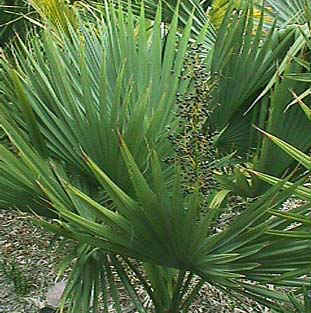
Plant Description
Caution & Interaction

Latin (botanical) name:
Sarenoa serrulata
Common names: Sabal, Sabal Serrulata
Plant Description: Saw Palmetto, native to Florida and surrounding areas of the United States, is a low-growing small palm tree with fanlike, fingery fronds and small berry-shpaed fruits. This plant grows about 6-10 feet high and forms what is called the 'palmetto scrub.' Large leaves form a crown, and it bears deep reddish-brown oblong-ovoid fruit. The fruit is slightly wrinkled and contains one hard seed.
Medicinal Properties &Uses: Native Americans recognized saw palmetto fruits as a food despite its rather unpleasant taste. They ate palmetto fruits for at least 12,000 years. Soon, they recognized the plant as medicinal. People native to Florida used infusions of the berries to treat stomach aches and dysentery, and for diuretic and sexual tonic. Saw Palmeto contains volatile oil, fixed oil, glucose, and free acids. The oil obtained from the fruit is a glyceride of fatty acids. Saw Palmetto is excellent for treating swollen or enlarged prostate, commonly called benign prostatic hyperplasia (BPH). Symptoms of BPH include difficulty in urinating, dull aches, impotence, difficulty maintaining an erection, urgency and waking to urinate. Saw Palmetto inhibits dihydrotestosterone, the compound that causes prostate cells to multiply excessively. Saw Palmetto is a very helpful tonic for men to help maintain their prostate health as they age. It has been proven to reduce inflammation and normalize an already enlarged prostate. As Saw Palmetto is non-toxic, it can be used long term. Most men achieve some relief of symptoms within the first 30 days after starting to take Saw Palmetto. In more than 20 controlled double-blind studies, it was shown that the lipidic extract of the berries standardized to contain 85-95% fatty acids and sterols is effective in relieving all the major symptoms of BPH, including increased nightime urinary frequency, which is the most bothersome complaint that sufferers report. In 1908, Saw Palmetto was listed in the United States Pharmacopoeia as a medicine for urinary tract infections. It is known to be not only diuretic, but sedative and tonic as well. It is not as much a stimulant as copaiba or sandalwood oil, but it is effective in treating chronic catarrh. It acts by reducing catarrhal irritation and relaxing bladder and urethra. It is a known tissue builder.
Dosage: 30-60 drops in water or juice, 2-3 times daily or as needed. Shake well before using.
Cautions & Interactions: Keep out of reach of children.
Efficacy Studies & Other Clinical Data:
Disclaimer (U.S. Only): These statements have not been evaluated by the FDA. These products are not intended to diagnose, cure, treat, or prevent any disease.
Common names: Sabal, Sabal Serrulata
Plant Description: Saw Palmetto, native to Florida and surrounding areas of the United States, is a low-growing small palm tree with fanlike, fingery fronds and small berry-shpaed fruits. This plant grows about 6-10 feet high and forms what is called the 'palmetto scrub.' Large leaves form a crown, and it bears deep reddish-brown oblong-ovoid fruit. The fruit is slightly wrinkled and contains one hard seed.
Medicinal Properties &Uses: Native Americans recognized saw palmetto fruits as a food despite its rather unpleasant taste. They ate palmetto fruits for at least 12,000 years. Soon, they recognized the plant as medicinal. People native to Florida used infusions of the berries to treat stomach aches and dysentery, and for diuretic and sexual tonic. Saw Palmeto contains volatile oil, fixed oil, glucose, and free acids. The oil obtained from the fruit is a glyceride of fatty acids. Saw Palmetto is excellent for treating swollen or enlarged prostate, commonly called benign prostatic hyperplasia (BPH). Symptoms of BPH include difficulty in urinating, dull aches, impotence, difficulty maintaining an erection, urgency and waking to urinate. Saw Palmetto inhibits dihydrotestosterone, the compound that causes prostate cells to multiply excessively. Saw Palmetto is a very helpful tonic for men to help maintain their prostate health as they age. It has been proven to reduce inflammation and normalize an already enlarged prostate. As Saw Palmetto is non-toxic, it can be used long term. Most men achieve some relief of symptoms within the first 30 days after starting to take Saw Palmetto. In more than 20 controlled double-blind studies, it was shown that the lipidic extract of the berries standardized to contain 85-95% fatty acids and sterols is effective in relieving all the major symptoms of BPH, including increased nightime urinary frequency, which is the most bothersome complaint that sufferers report. In 1908, Saw Palmetto was listed in the United States Pharmacopoeia as a medicine for urinary tract infections. It is known to be not only diuretic, but sedative and tonic as well. It is not as much a stimulant as copaiba or sandalwood oil, but it is effective in treating chronic catarrh. It acts by reducing catarrhal irritation and relaxing bladder and urethra. It is a known tissue builder.
Dosage: 30-60 drops in water or juice, 2-3 times daily or as needed. Shake well before using.
Cautions & Interactions: Keep out of reach of children.
Efficacy Studies & Other Clinical Data:
-
Saw palmetto and prostatic hypertrophy
-
Ohio State University Extension Fact Sheet - Saw Palmetto
-
Pro Health Network.com - A Medical Expert on the Efficacy of Saw Palmetto
Disclaimer (U.S. Only): These statements have not been evaluated by the FDA. These products are not intended to diagnose, cure, treat, or prevent any disease.